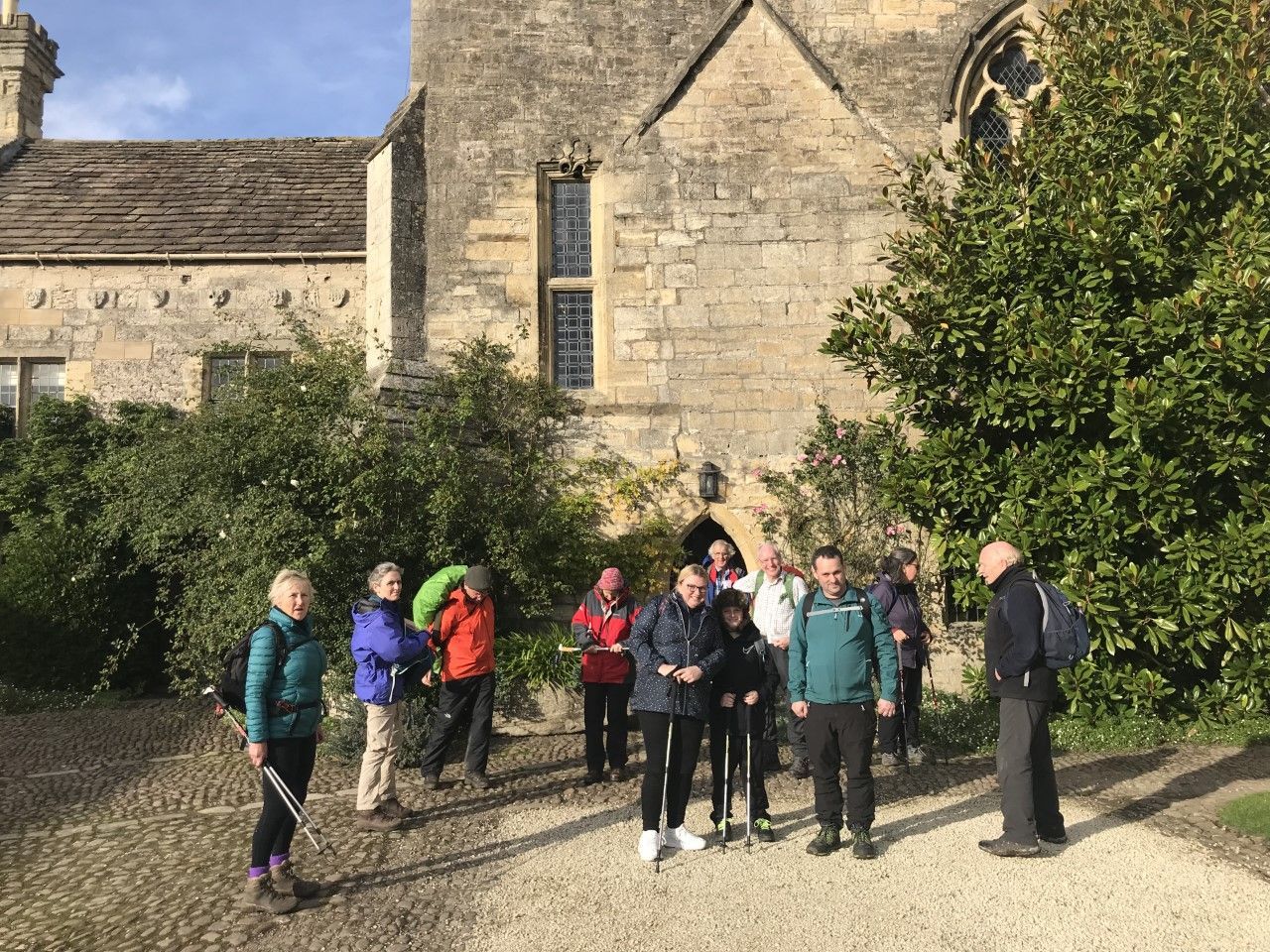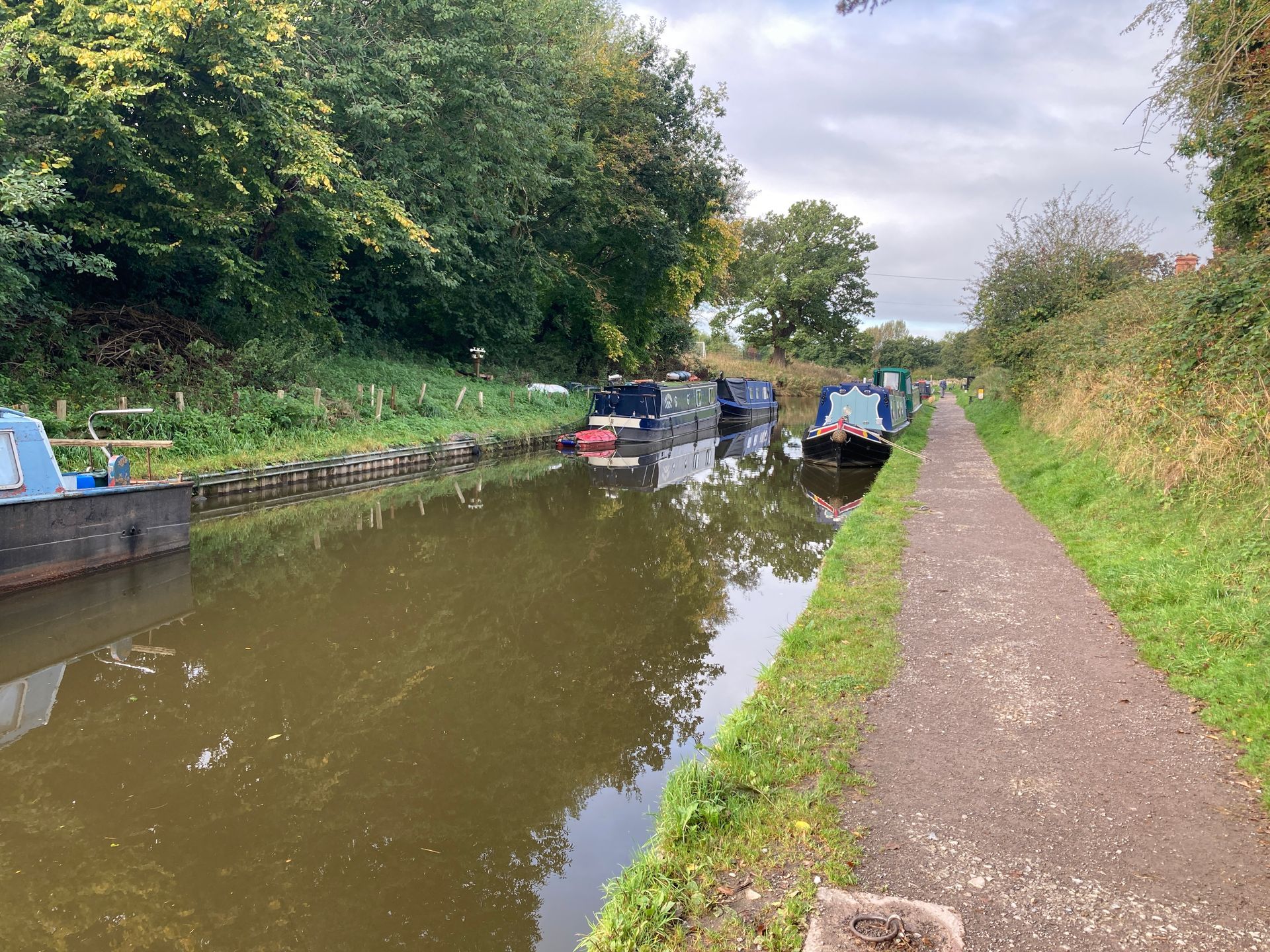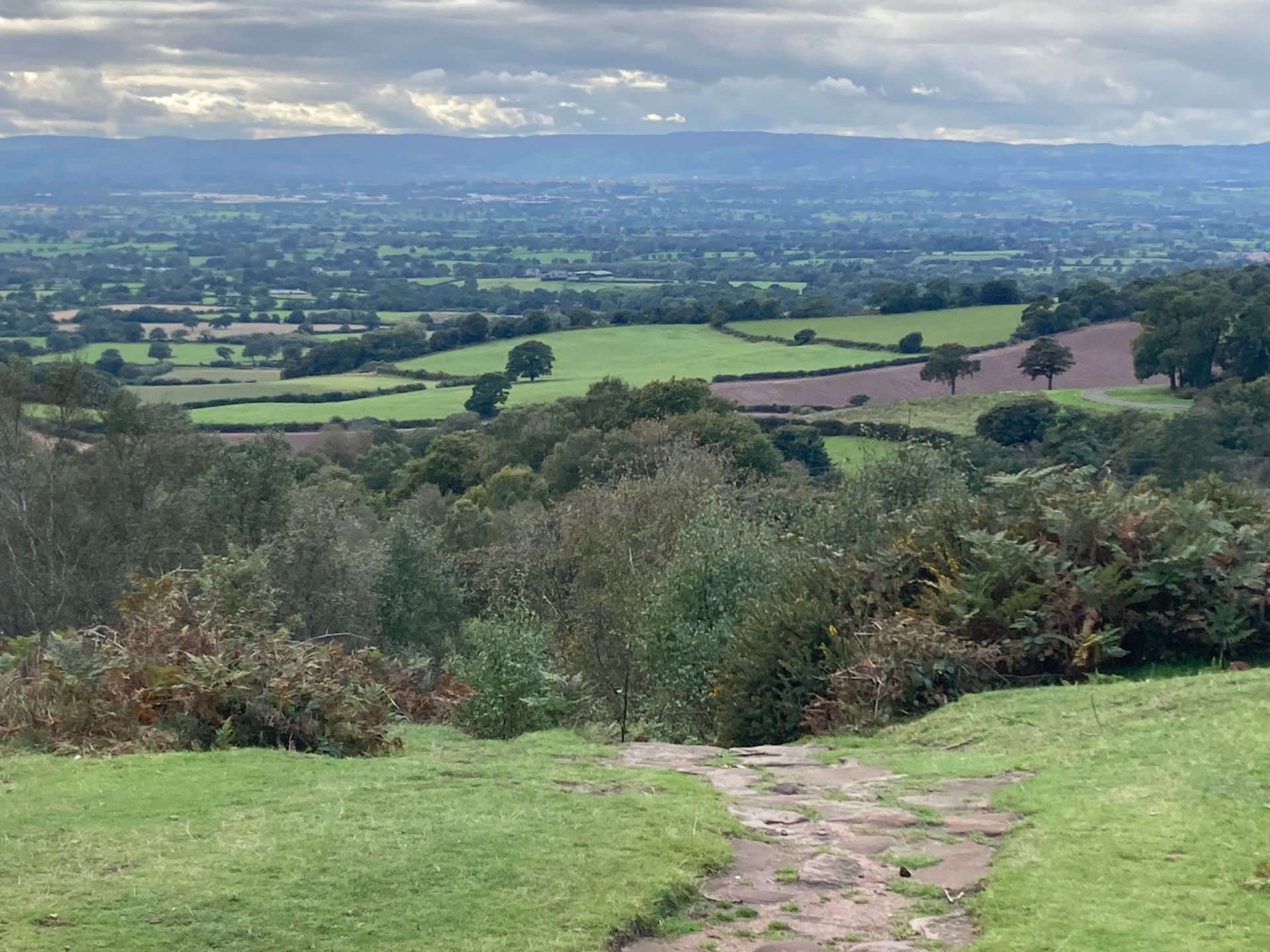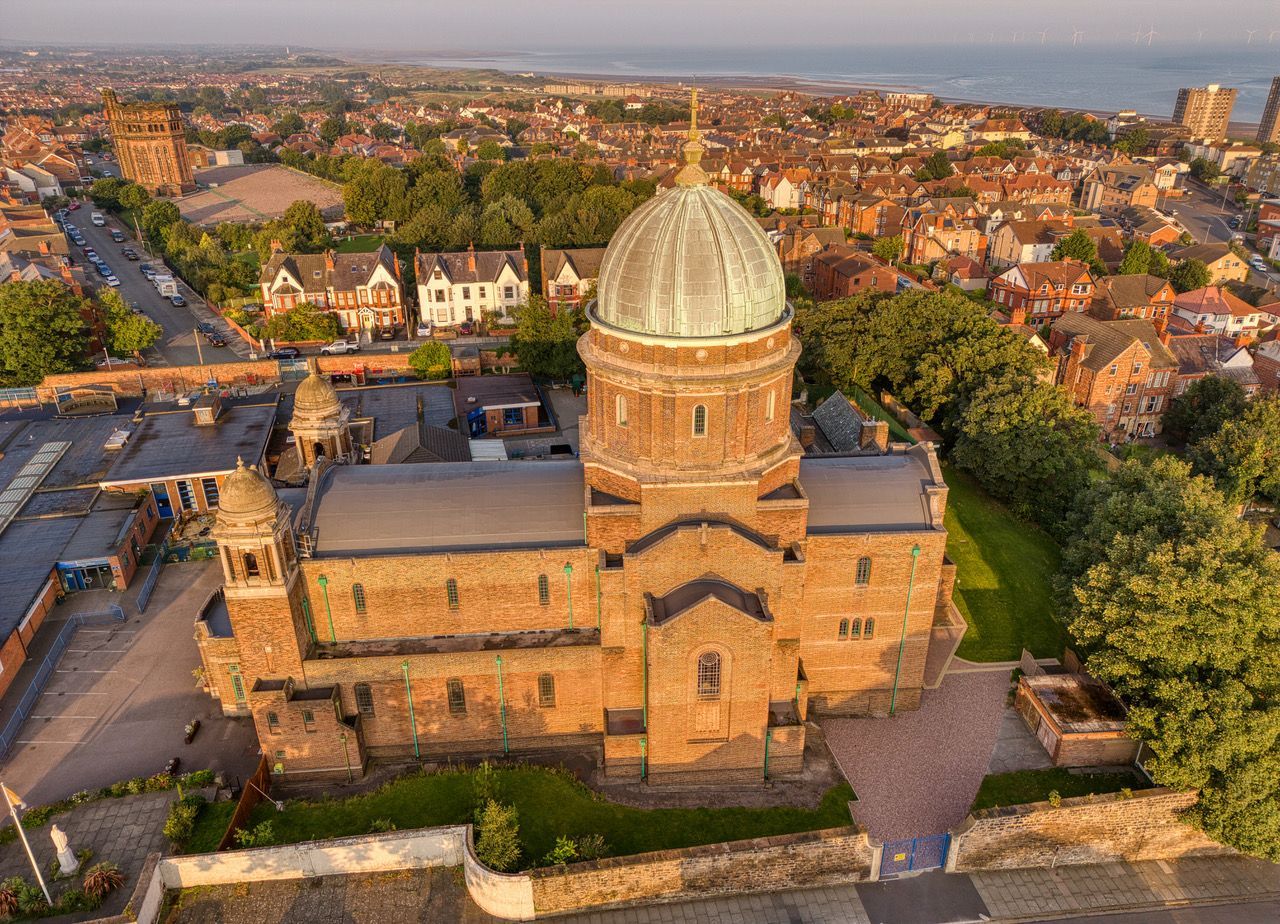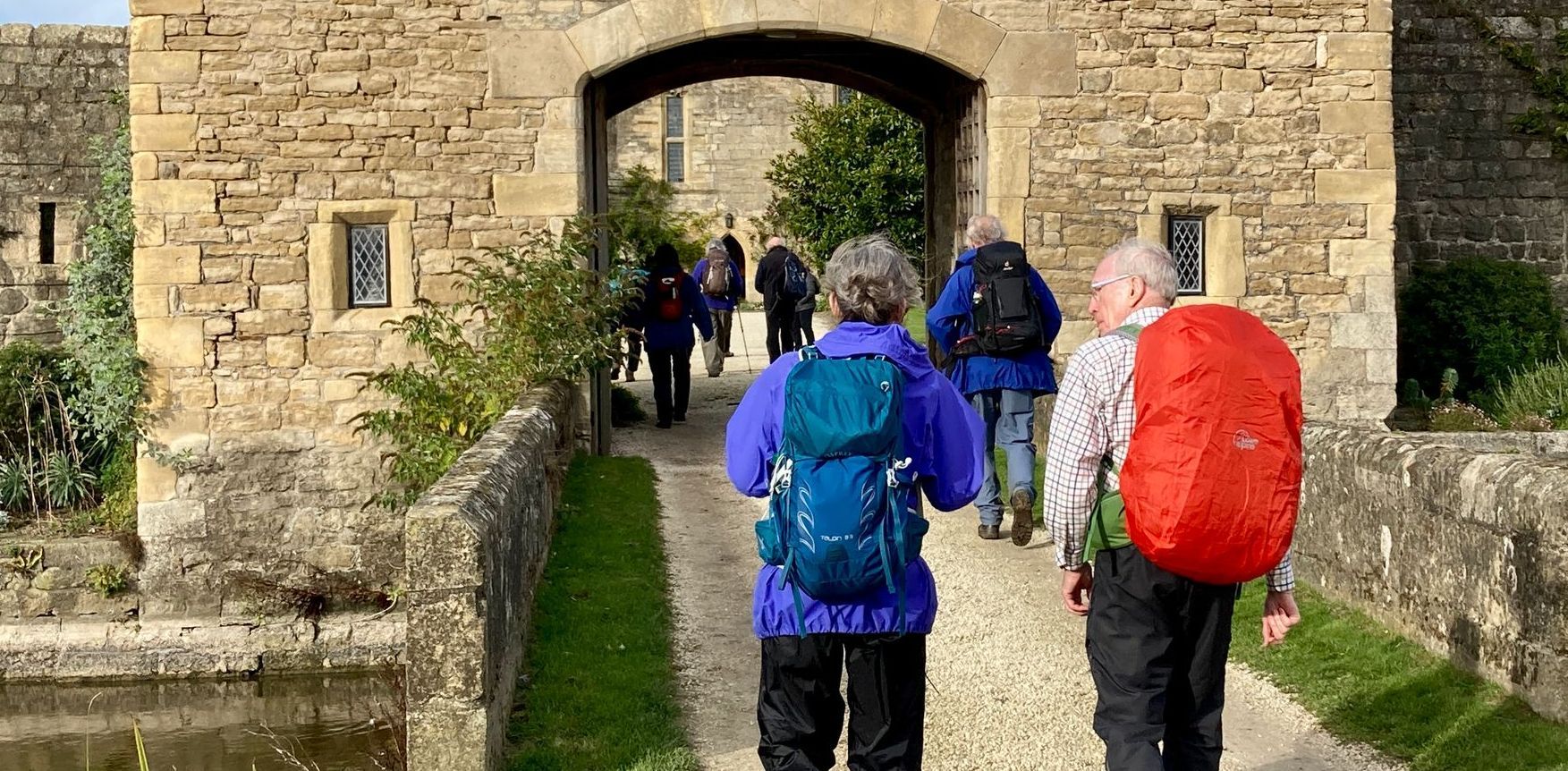The St Philomena's Way
A Pilgrim Way for the Diocese of Shrewsbury from the Cathedral of Our Lady Help of Christians in Shrewsbury to the Shrine Church of Ss Peter & Paul and St Philomena in New Brighton
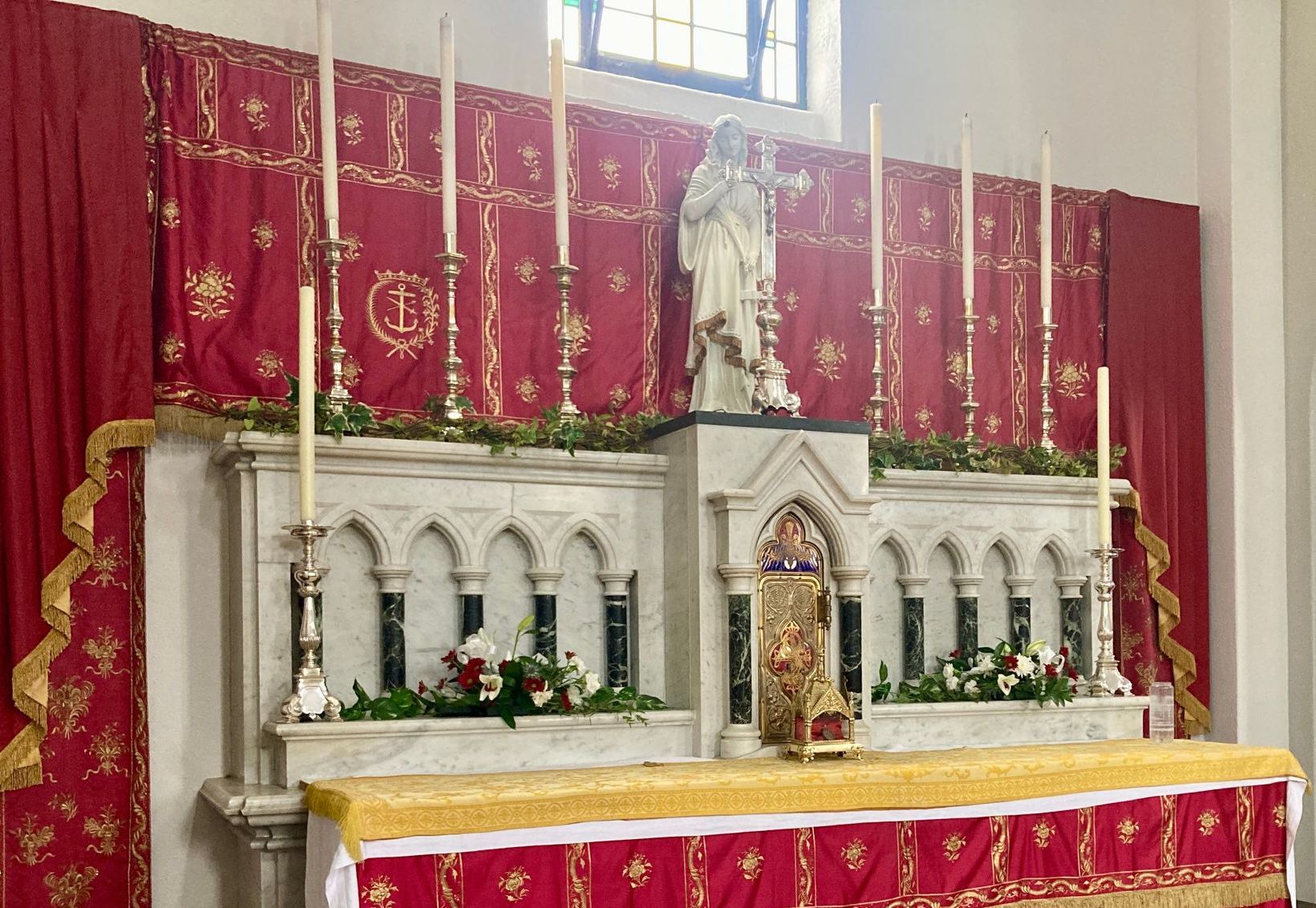
The Shrine of St Philomena, New Brighton
About the route
St Philomena was a C4 virgin martyr whose remains were discovered in 1802 in the Catacomb of Priscilla. She is the patron saint of infants, babies, and youth.
The Way passes Shrewsbury Abbey and then follows the north bank of the River Severn out of Shrewsbury to reach the remains of Haughmond Abbey. The Way follows the Shropshire Way to Wen and the Church of Our Lady of Perpetual Succour. The path follows the Shropshire Way to Hollingwood where the route continues north across farmland to reach the Church of St George, Whitchurch. From Whitchurch the Way follows a north-west direction along the beautiful Sandstone Trail. Farmland is crossed to reach the Shropshire Union Canal and follow the Two Saints Way to Chester. After passing the Churches of St Werburgh and St Francis Assisi and Chester Cathedral the Way re-joins the Shropshire Union Canal to the Church of Our Lady, Star of the Sea, Ellesmere Port.
Here pilgrims can ether take the train straight to New Brighton or walk on through the Wirral with its rich Catholic history. Walkers may visit St Patrick’s Well, Port Sunlight, and the churches of Christ the King, Bromborough; St John the Evangelist, New Ferry; St Anne, Rock Ferry; St Joseph, Birkenhead; St Werburgh, Birkenhead; Our Lady of the Immaculate Conception, Birkenhead; and Our Lady, Star of the Sea, & St Joseph, Wallasey. The route reaches the Mersey estuary and the King Charles III England Coast Path before finally turning inland to the Shrine Church of Ss Peter & Paul and St Philomena, New Brighton.
You can find out more about the Way and download the GPX file by clicking on the LEARN MORE tab in the
interactive map below
Guidance
You can use the tabs in this section to find the information you need for your pilgrimage.
The Outer Way provides practical advice about the route.
The Inner Way describes the spiritual highlights.
Walking guidance: click the button below to download the details of the inner and outer way, walking guidance and maps.
Stages: route, food & drink, accommodation and public transport
1. The Cathedral of Our Lady Help of Christians, Shrewsbury to the Church of Our Lady of Perpetual Succour, Wem – 16.4 miles
The Cathedral can be reached by foot from Shrewsbury rail and bus stations. The route passes Shrewsbury Abbey and then follows the River Severn and the Shropshire Way. There are plenty of shops, pubs, restaurants and accommodation in Shrewsbury. There is a pub in Uffington, and a pub and shop in Hadnall on the main road. The Church of Our Lady of Perpetual Succour is only open for Mass. The Anglican church of SS Peter & Paul on the High St has a church hall beside it which is often open for tea and coffee. There are plenty of shops, pubs, cafés and some accommodation in Wem. There are occasional buses from Shrewsbury to Haughmond Abbey. There is a railway station in Wem and buses from Wem and Hadley.
2. The Church of Our Lady of Perpetual Succour, Wem to the Church of St George, Protector of England, Whitchurch – 10.7 miles
The route generally follows the Shropshire Way to Hollingwood and then crosses quiet farmland. There are no facilities enroute. There are plenty of shops, pubs, cafés and accommodation in Whitchurch. There is a railway station in Whitchurch and buses.
3. The Church of Church of St George, Protector of England, Whitchurch to Higher Burwardsley – 15.5 miles
The route follows the Llangollen Canal to Willeymoor Lock and then the Sandstone Trail, including some beautiful walking. There is a pub and a café at Grindley Brook and a pub at Willeymoor Lock. There is a caravan site at Grindley Brook. The pub at Higher Burwardsley provides accommodation and there is Airbnb accommodation nearby.
4. Higher Burwardsley to the Church of St Werburgh, Chester – 10.7 miles
The route crosses farmland to reach the Shropshire Union Canal and then follows this to Chester. There is no access to the marina facilities at Crows Nest Bridge. There are canal side pubs on the approach to Chester, a café and a supermarket. There are plenty of shops, pubs, cafés and accommodation in Chester. There is a railway station in Chester and a bus and coach station nearby.
5. The Church of St Werburgh, Chester to the Church of Our Lady, Star of the Sea, Ellesmere Port – 9.9 miles
The route continues along the Shropshire Union Canal almost all the way. There are pubs, cafes and some accommodation in Ellesmere Port. There is a train station and a bus interchange near the church.
6. The Church of Our Lady, Star of the Sea, Ellesmere Port to the Church of St Anne, Rock Ferry – 10.1 miles
At first the route is through commercial and industrial areas with some parkland. Port Sunlight is a fascinating arts and crafts model village. There is a café at Eastham Country Park visitor centre and shops, pubs, cafés and accommodation at Bromborough Village. There is a café in the Lady Lever Art Gallery in Port Sunlight. There are several railway stations near the route and the bus service can be accessed in several places.
7. The Church of St Anne, Rock Ferry to the Shrine Church of SS Peter & Paul and St Philomena, New Brighton – 7.9 miles
The route includes some industrial and commercial areas and finally urban coastal path. There are plenty of shops, pubs, cafés, restaurants and accommodation in Birkenhead and some in New Brighton. There are several railway stations near the route and the bus service can be accessed in several places and there is a bus station in Birkenhead.
Public transport links
Trains:
https://www.nationalrail.co.uk/
Coaches:
https://www.nationalexpress.com/en
Buses:
https://next.shropshire.gov.uk/public-transport/travelling-by-bus/bus-services
https://www.wirral.gov.uk/parking-roads-and-travel/public-transport
Pilgrim People and Places
NB Many churches are closed during daylight hours. If you would like to visit the churches and shrines it is best to check the parish website first. You can also email or phone the parish office to see is someone would be willing to open the church. Please be aware that many priests cover more than one church and so may live many miles away.
The Cathedral of Our Lady Help of Christians & Saint Peter of Alcantara, Shrewsbury
A chapel was built in Town Walls in 1776, 15 years before the building of public Catholic chapels became legal. The building was discreetly located behind the priest’s house, which in turn was set back from the road. This chapel was enlarged in 1826 to seat 250 and extended again in 1840. The site of what is now the cathedral was purchased in the late 1840s. With the restoration of the Catholic hierarchy in 1850, the Diocese of Shrewsbury was created, partly in honour of the 16th Earl of Shrewsbury, a great benefactor to the Catholic Church in England. A.W.N. Pugin: was appointed architect but after he died in 1852 the task passed to his son E.W. Pugin. The foundation stone was laid on 12 December 1853. Lord Shrewsbury chose the dedication, to Our Lady of the Immaculate Conception and St Peter of Alcantara, a Spanish Franciscan from whose intercession he believed he had benefitted. Pope Pius IX suggested a change of the first part of the dedication to Our Lady Help of Christians. The cathedral was opened in 1856 and consecrated in 1890. The external appearance is modest due to site constraints; an intended tower and spire were never built. The building has been augmented over the years. Most recently the 1980s re-ordering has been reversed, access improved, and original decorations restored.
The Church of Our Lady of Perpetual Succour, Wem
In the years after WW II Wem’s few Catholics worshipped at various Mass centres, in pubs, restaurants and the Polish camp outside the town. A donation by the Evans family of a plot close to the town centre allowed for the building of a church in 1962. This flat-roofed building was replaced in 1991 with the current brick built multi-purpose church and hall. The church is served from Ellesmere and is only open for Mass.
The Church of St George, Protector of England, Whitchurch
The church is a simple Gothic school-chapel of 1878 by James O’Byrne. The presbytery is one of a pair of late Georgian town houses given to the mission. The original narthex was lost in 1914 when the gallery was built. In 1906 of a new altar and reredos were installed. The church was reordered in 1969 and again in 1985. There is good post-war stained glass in the sanctuary.
The Church of St Werburgh, Chester
A church and presbytery were built in Queen Street, Chester in 1799. In 1847 Daniel O’Connell, the great campaigner for Catholic Emancipation, died in Rome. His body rested in the church enroute for burial in Ireland. By the 1860s the Catholic population had outgrown the church, and a site for a new, larger building was found. A large stone-built church in the French lancet Gothic style was built and was ready for use by the end of 1875. The building was completed in stages and a proposed tower and spire were never built. Many changes were made over the year and a radical reordering took place in 2002-03. The St Werburgh screen was relocated to form a shrine in the north aisle and the War Memorial chapel restored.
The Church of St Francis of Assisi, Chester
The Capuchin Franciscans established a mission in Chester in 1858. Mass was said in the bishop’s house, later moving to a wooden building on Watergate Street. The site of the present church was acquired in 1862 and the foundation stone laid that year. The building works were fraught with setbacks: the first contractor failed, in October 1863 an earthquake demolished the east front, and in December that year a hurricane destroyed the almost-complete building. The new church was opened in 1875, with Cardinal Manning presiding. The friary opened in 1876 and a school built in 1882. In 1932-3 the church was restored and redecorated.
The Church of Our Lady, Star of the Sea, Ellesmere Port
A ‘tin tabernacle’ was opened in 1909 as the first Catholic church in Ellesmere Port. It was replaced by the present building in 1930-31. It is an example of the simple bold forms of the ‘primitive’ Romanesque and Byzantine type popular between the wars. The baldacchino was added in 1932. The flanking ‘mosaics’ were made in the 1970s of card by local schoolchildren to Byzantine designs.
The Church of Christ the King, Bromborough
Mass was first said in Bromborough in 1928 at the Council Offices. In 1933 work started on construction of a church, which was opened on 24 September of the same year. By 1961 the church had deteriorated, and it was decided to replace it with a larger building. The new church was opened in 1964 and the old church was converted to a parish hall. The current church is a prominent landmark on the busy New Chester Road. The lofty interior is plain with some good bronze work.
The Church of St John the Evangelist, New Ferry
A mission was established at New Ferry in 1902, with Mass being said in the assembly rooms (now the post office). Land had already been purchased for a church. At first a school-chapel was erected at the rear of the site in 1903 and a presbytery in 1906. The well-proportioned church with a tall west front was erected in 1934. 1950 the interior of the church was redecorated: the walls of the sanctuary were faced in marble, and the dome over the sanctuary was painted with symbols of the four Evangelists, the Lamb and the Holy Ghost. A baldachin of silver bronze was placed above the altar and a rood was hung from the sanctuary arch as a memorial to those who lost their lives in WW II. The paintings were lost in the late 1970s and the baldachin was removed when the sanctuary was reordered in accordance with the post-Vatican II liturgy.
The Church of St Anne, Rock Ferry
A mission was established at Rock Ferry in 1862. The Missionary Oblates of Mary Immaculate were invited from their centre at Holy Cross, Liverpool. Mass was said for two years in the back of a bakery in St Paul’s Road. A large house was built by E. W. Pugin for oblates, a novitiate, and a rest house for priests working in slum parishes. The Holy Family Sisters arrived and opened an infants’ school in 1872. Work on a church started in 1875 to a design by E.W. Pugin, with the work completed by his brothers after his death. In 1934 the church was enlarged by two side aisles. The Lourdes Memorial Hall was built in 1910 and has been extended 3 times, becoming the parish social centre. In the 1970s the convent buildings, including E.W. Pugin’s original house, were taken down and replaced by the present Convent of the Holy Family. The Oblates left in 2009, since when the parish has been served by diocesan clergy.
The Church of St Joseph, Birkenhead
The mission was established in 1898. The land for a church was provided by a local benefactor. The foundation stone was laid in 1899 and the church opened in August 1900. The building is of grand proportions with skilful use of pressed and moulded bricks to give complexity and surface richness inside and out. The organ gallery and narthex screen were introduced in 1910 and the organ was installed in 1911. In 1923 a temporary high altar was replaced by the carved oak altar and reredos, manufactured in Salzburg, and the altar rails were erected. The sanctuary was reordered in 1968; the organ was restored, and the organ gallery redecorated in 1971; and the overall redecoration of the church with extensive stencil patterning was carried out in 1986. The church is part of the Parish of St Philip Neri which also includes St Michael and All Angels, Woodchurch.
The Church of SS Werburgh & Laurence, Birkenhead
A mission was founded in Birkenhead in 1834, when Mass was first offered in the remains of the former Benedictine priory. A year later the foundation was laid for the new church, dedicated to St Werburgh because of the links with Chester, whose abbey was named after the saint. There were few local Catholics, and the church was described in the press as the ‘Catholic Folly’. It opened in 1837, soon after the Catholic Emancipation Act, and had to be guarded at night. St Werburgh’s is the oldest Catholic church in the Wirral and is built in the Greek Revival style. There were girls’ and infants’ schools in the grounds, but these were destroyed in the blitz of 1941. The church lost its original interior due to a reordering in 1970-72 following an outbreak of dry rot. In 2006 the parish was amalgamated with that of St Laurence, Beckwith Street and that church closed.
The Church of Our Lady of the Immaculate Conception, Birkenhead
The population of the north end of Birkenhead increased rapidly in the 1850s with the construction of the docks. At the time St Werburgh’s was the only Mass centre in Birkenhead so land was acquired for a new church. When it was realised that the cathedral site in Shrewsbury was incapable of accommodating a large building, the Earl of Shrewsbury suggested that a cathedral be built on the Birkenhead site and offered funding. E.W. Pugin was engaged and produced a design for a cathedral. A school was built to Pugin’s design, which opened in 1856, but shortly afterwards the Earl died, and the title passed to a Protestant branch of the family. Loss of the principal patron had a lasting impact on the project and because of the proximity to Liverpool it was decided that Shrewsbury would be a better site for the cathedral. Work started on the church in 1860, but only the nave and aisles were completed, the chancel being added by Pugin & Pugin in 1876-7 to a simplified design. The tower never rose above eaves level, and the sacristies wrapping around the chancel appear to have been added later still. The church was badly damaged in the blitz of March 1941, when the presbytery was destroyed, and the Canon and his housekeeper were killed. For 10 years the church was left open to the skies. The celebrations at its re-opening in 1951 were said to have been unprecedented in the diocese. The church is part of the Parish of Holy Cross, Our Lady & Saint Paul.
The Church of Our Lady, Star of the Sea, & St Joseph, Seacombe, Wallasey
The Seacombe mission was founded in 1860. Mass was said in an upper room of a house in Chapel Street. In 1862 a house was purchased for a presbytery and a school-chapel. The population grew rapidly and in 1870 a plot of land was purchased in Wheatland Lane. 5 years later the present presbytery and schools were erected, part of the school being used as a chapel. In 1883, a legacy of £9,000 was left to the diocese of which the bishop granted £5,000 towards a new church. The church was opened in July 1889 and is a lofty and imposing building with a well-proportioned interior with a high altar and reredos panelled in fine coloured marbles. The church suffered slight bomb damage in WW II, after which it was renovated, fitted with new benches and Stations of the Cross. There was a re-ordering following the reforms of the Second Vatican Council and again in 2006. There is high quality early C20 stained glass. The parish is linked with St Alban’s, Liscard.
The Shrine Church of Ss Peter & Paul and St Philomena, New Brighton
In 1879 a room was rented in Egerton Street where Mass was said for Catholics of New Brighton. In 1881 a church dedicated to Ss Peter & Paul was opened and a school was erected close by. In 1909 Fr Thomas Mullins was appointed rector. His vision was to build a great church that would serve as a beacon for Catholicism far and wide. In the early C20 New Brighton was a rapidly growing seaside resort and a commuter suburb for Liverpool. The site selected was in Atherton Street at the top of St George’s Mount, the highest point of New Brighton. The church opened in August 1935. It is monumental in scale and in the baroque style. The 85’ diameter dome is nicknamed "The Dome of Home" from when sailors would recognise that they were close to Merseyside when they could see it. Inside it is simply ornamented but the high altar and side chapels are clad in sumptuous marbles. In 2006 the church was threatened with closure, a prospect that met with local opposition and led to a successful application for it to be listed. In 2008 the diocese agreed to lease the church to the Institute of Christ the King, a society dedicated to the celebration of the pre-1962 Latin Mass.
In 2013 the altar of St. Philomena was installed in the south aisle. The fine neo-Gothic altar was rescued from a closed convent chapel in Scotland. The enamel on the tabernacle door shows the Pelican in her Piety, a symbol of the Eucharist, since according to the old legend, the pelican nursed her young by piercing her breast and nourishing them with her own blood. Above the tabernacle is a statue of St. Philomena and a small, gilded reliquary containing a relic of this early Christian martyr.
ABOUT THE DIOCESE OF SHREWSBURY
The Catholic Diocese of Shrewsbury encompasses the pre-1974 counties of Shropshire and Cheshire in the North West and West Midlands of England. The diocese includes rural areas of Shropshire as well as Manchester south of the River Mersey and other urban areas such as Birkenhead, Stockport and Ellesmere Port. Before 1895, it also included North Wales. In 2007, new pastoral areas and regions were created, replacing the former deaneries. The Diocese includes more than a 170,000 faithful, in a hundred communities.
Copyright Hearts in Search of God - Pilgrim Way Project (England and Wales)
Web Design by Catholic Marketing Agency: Every Day Christian Marketing
